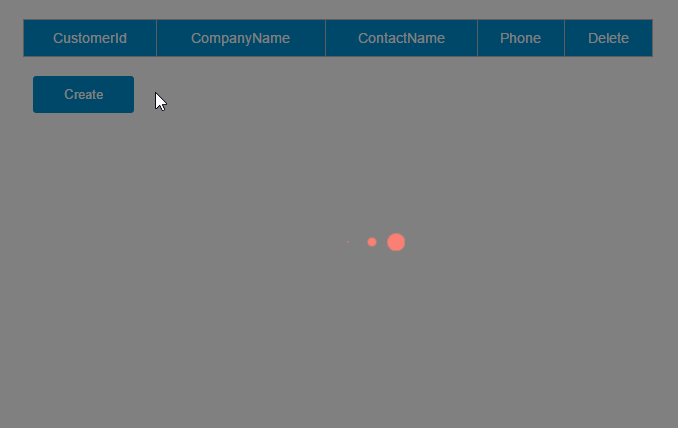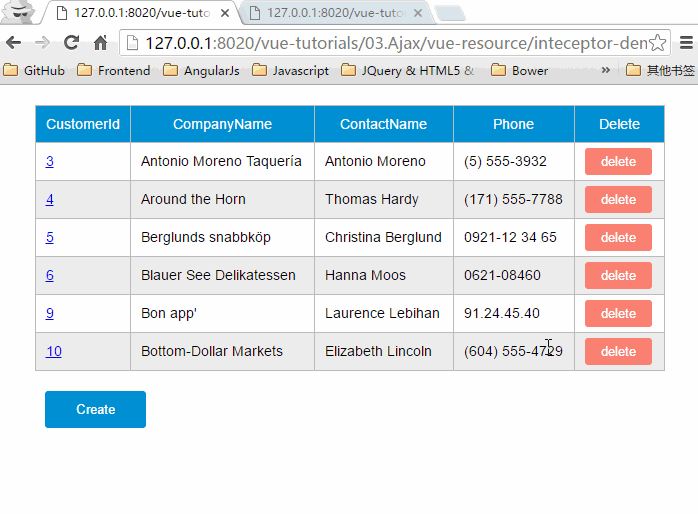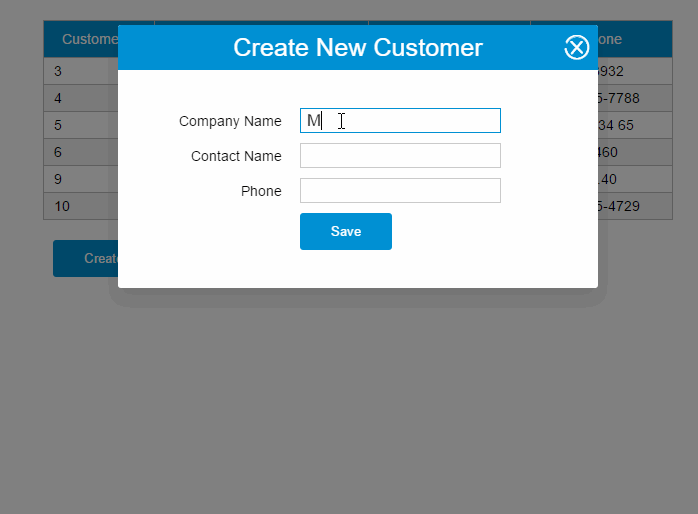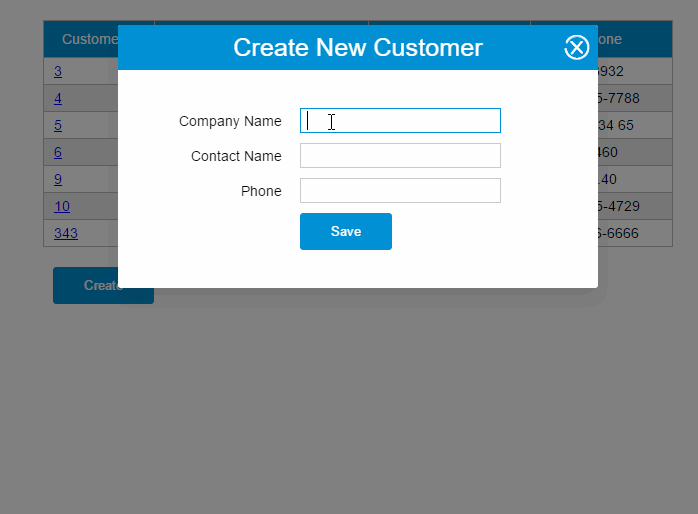Vue.js——vue-resource全攻略
概述
上一篇我們介紹了如何將$.ajax和Vue.js結合在一起使用,并實現了一個簡單的跨域CURD示例。Vue.js是數據驅動的,這使得我們并不需要直接操作DOM,如果我們不需要使用jQuery的DOM選擇器,就沒有必要引入jquery。vue-resource是Vue.js的一款插件,它可以通過XMLHttpRequest或JSONP發起請求并處理響應。也就是說,$.ajax能做的事情,vue-resource插件一樣也能做到,而且vue-resource的API更為簡潔。另外,vue-resource還提供了非常有用的inteceptor功能,使用inteceptor可以在請求前和請求后附加一些行為,比如使用inteceptor在ajax請求時顯示loading界面。
本文的主要內容如下:
- 介紹vue-resource的特點
- 介紹vue-resource的基本使用方法
- 基于this.$http的增刪查改示例
- 基于this.$resource的增刪查改示例
- 基于inteceptor實現請求等待時的loading畫面
- 基于inteceptor實現請求錯誤時的提示畫面
本文11個示例的源碼已放到GitHub,如果您覺得本篇內容不錯,請點個贊,或在GitHub上加個星星!
本文的所有示例如下:
- http get示例
- http jsonp示例
- http post示例
- http put示例
- http delete示例
- resource get示例
- resource save示例(HTTP POST)
- resource update示例(HTTP PUT)
- resource remove示例(HTTP DELETE)
- inteceptor示例1——ajax請求的loading界面
- inteceptor實例2——請求失敗時的提示對話框
各位在閱讀這篇文章的內容時,可以先嘗試該列表的最后兩個示例,這兩個示例綜合使用了this.$http和inteceptor。
vue-resource特點
vue-resource插件具有以下特點:
1. 體積小
vue-resource非常小巧,在壓縮以后只有大約12KB,服務端啟用gzip壓縮后只有4.5KB大小,這遠比jQuery的體積要小得多。
2. 支持主流的瀏覽器
和Vue.js一樣,vue-resource除了不支持IE 9以下的瀏覽器,其他主流的瀏覽器都支持。
3. 支持Promise?API和URI Templates
Promise是ES6的特性,Promise的中文含義為“先知”,Promise對象用于異步計算。
URI Templates表示URI模板,有些類似于ASP.NET?MVC的路由模板。
4. 支持攔截器
攔截器是全局的,攔截器可以在請求發送前和發送請求后做一些處理。
攔截器在一些場景下會非常有用,比如請求發送前在headers中設置access_token,或者在請求失敗時,提供共通的處理方式。
vue-resource使用
引入vue-resource
<script src="js/vue.js"></script>
<script src="js/vue-resource.js"></script>
基本語法
引入vue-resource后,可以基于全局的Vue對象使用http,也可以基于某個Vue實例使用http。
// 基于全局Vue對象使用http
Vue.http.get('/someUrl', [options]).then(successCallback, errorCallback);
Vue.http.post('/someUrl', [body], [options]).then(successCallback, errorCallback);// 在一個Vue實例內使用$http
this.$http.get('/someUrl', [options]).then(successCallback, errorCallback);
this.$http.post('/someUrl', [body], [options]).then(successCallback, errorCallback);在發送請求后,使用then方法來處理響應結果,then方法有兩個參數,第一個參數是響應成功時的回調函數,第二個參數是響應失敗時的回調函數。
then方法的回調函數也有兩種寫法,第一種是傳統的函數寫法,第二種是更為簡潔的ES 6的Lambda寫法:
// 傳統寫法
this.$http.get('/someUrl', [options]).then(function(response){// 響應成功回調
}, function(response){// 響應錯誤回調
});// Lambda寫法
this.$http.get('/someUrl', [options]).then((response) => {// 響應成功回調
}, (response) => {// 響應錯誤回調
});PS:做過.NET開發的人想必對Lambda寫法有一種熟悉的感覺。
支持的HTTP方法
vue-resource的請求API是按照REST風格設計的,它提供了7種請求API:
get(url, [options])head(url, [options])delete(url, [options])jsonp(url, [options])post(url, [body], [options])put(url, [body], [options])patch(url, [body], [options])
除了jsonp以外,另外6種的API名稱是標準的HTTP方法。當服務端使用REST API時,客戶端的編碼風格和服務端的編碼風格近乎一致,這可以減少前端和后端開發人員的溝通成本。
| 客戶端請求方法 | 服務端處理方法 |
|---|---|
| this.$http.get(...) | Getxxx |
| this.$http.post(...) | Postxxx |
| this.$http.put(...) | Putxxx |
| this.$http.delete(...) | Deletexxx |
options對象
發送請求時的options選項對象包含以下屬性:
| 參數 | 類型 | 描述 |
|---|---|---|
| url | string | 請求的URL |
| method | string | 請求的HTTP方法,例如:'GET', 'POST'或其他HTTP方法 |
| body | Object,?FormDatastring | request body |
| params | Object | 請求的URL參數對象 |
| headers | Object | request header |
| timeout | number | 單位為毫秒的請求超時時間 (0?表示無超時時間) |
| before | function(request) | 請求發送前的處理函數,類似于jQuery的beforeSend函數 |
| progress | function(event) | ProgressEvent回調處理函數 |
| credientials | boolean | 表示跨域請求時是否需要使用憑證 |
| emulateHTTP | boolean | 發送PUT, PATCH, DELETE請求時以HTTP POST的方式發送,并設置請求頭的X-HTTP-Method-Override |
| emulateJSON | boolean | 將request body以application/x-www-form-urlencoded?content type發送 |
emulateHTTP的作用
如果Web服務器無法處理PUT, PATCH和DELETE這種REST風格的請求,你可以啟用enulateHTTP現象。啟用該選項后,請求會以普通的POST方法發出,并且HTTP頭信息的X-HTTP-Method-Override屬性會設置為實際的HTTP方法。
Vue.http.options.emulateHTTP = true;emulateJSON的作用
如果Web服務器無法處理編碼為application/json的請求,你可以啟用emulateJSON選項。啟用該選項后,請求會以application/x-www-form-urlencoded作為MIME type,就像普通的HTML表單一樣。
Vue.http.options.emulateJSON = true;response對象
response對象包含以下屬性:
| 方法 | 類型 | 描述 |
|---|---|---|
| text() | string | 以string形式返回response body |
| json() | Object | 以JSON對象形式返回response body |
| blob() | Blob | 以二進制形式返回response body |
| 屬性 | 類型 | 描述 |
| ok | boolean | 響應的HTTP狀態碼在200~299之間時,該屬性為true |
| status | number | 響應的HTTP狀態碼 |
| statusText | string | 響應的狀態文本 |
| headers | Object | 響應頭 |
注意:本文的vue-resource版本為v0.9.3,如果你使用的是v0.9.0以前的版本,response對象是沒有json(), blob(), text()這些方法的。
CURD示例
提示:以下示例仍然沿用上一篇的組件和WebAPI,組件的代碼和頁面HTML代碼我就不再貼出來了。
GET請求
var demo = new Vue({el: '#app',data: {gridColumns: ['customerId', 'companyName', 'contactName', 'phone'],gridData: [],apiUrl: 'http://211.149.193.19:8080/api/customers'},ready: function() {this.getCustomers()},methods: {getCustomers: function() {this.$http.get(this.apiUrl).then((response) => {this.$set('gridData', response.data)}).catch(function(response) {console.log(response)})}}
})
這段程序的then方法只提供了successCallback,而省略了errorCallback。
catch方法用于捕捉程序的異常,catch方法和errorCallback是不同的,errorCallback只在響應失敗時調用,而catch則是在整個請求到響應過程中,只要程序出錯了就會被調用。
在then方法的回調函數內,你也可以直接使用this,this仍然是指向Vue實例的:
getCustomers: function() {this.$http.get(this.apiUrl).then((response) => {this.$set('gridData', response.data)}).catch(function(response) {console.log(response)})
}為了減少作用域鏈的搜索,建議使用一個局部變量來接收this。

JSONP請求
getCustomers: function() {this.$http.jsonp(this.apiUrl).then(function(response){this.$set('gridData', response.data)})
}
POST請求
var demo = new Vue({el: '#app',data: {show: false,gridColumns: [{name: 'customerId',isKey: true}, {name: 'companyName'}, {name: 'contactName'}, {name: 'phone'}],gridData: [],apiUrl: 'http://211.149.193.19:8080/api/customers',item: {}},ready: function() {this.getCustomers()},methods: {closeDialog: function() {this.show = false},getCustomers: function() {var vm = thisvm.$http.get(vm.apiUrl).then((response) => {vm.$set('gridData', response.data)})},createCustomer: function() {var vm = thisvm.$http.post(vm.apiUrl, vm.item).then((response) => {vm.$set('item', {})vm.getCustomers()})this.show = false}}
})
PUT請求
updateCustomer: function() {var vm = thisvm.$http.put(this.apiUrl + '/' + vm.item.customerId, vm.item).then((response) => {vm.getCustomers()})
}
Delete請求
deleteCustomer: function(customer){var vm = thisvm.$http.delete(this.apiUrl + '/' + customer.customerId).then((response) => {vm.getCustomers()})
}
使用resource服務
vue-resource提供了另外一種方式訪問HTTP——resource服務,resource服務包含以下幾種默認的action:
get: {method: 'GET'},
save: {method: 'POST'},
query: {method: 'GET'},
update: {method: 'PUT'},
remove: {method: 'DELETE'},
delete: {method: 'DELETE'}resource對象也有兩種訪問方式:
- 全局訪問:
Vue.resource - 實例訪問:
this.$resource
resource可以結合URI Template一起使用,以下示例的apiUrl都設置為{/id}了:
apiUrl: 'http://211.149.193.19:8080/api/customers{/id}'GET請求
使用get方法發送GET請求,下面這個請求沒有指定{/id}。
getCustomers: function() {var resource = this.$resource(this.apiUrl)vm = thisresource.get().then((response) => {vm.$set('gridData', response.data)}).catch(function(response) {console.log(response)})
}POST請求
使用save方法發送POST請求,下面這個請求沒有指定{/id}。
createCustomer: function() {var resource = this.$resource(this.apiUrl)vm = thisresource.save(vm.apiUrl, vm.item).then((response) => {vm.$set('item', {})vm.getCustomers()})this.show = false
}
PUT請求
使用update方法發送PUT請求,下面這個請求指定了{/id}。
updateCustomer: function() {var resource = this.$resource(this.apiUrl)vm = thisresource.update({ id: vm.item.customerId}, vm.item).then((response) => {vm.getCustomers()})
}
{/id}相當于一個占位符,當傳入實際的參數時該占位符會被替換。
例如,{ id: vm.item.customerId}中的vm.item.customerId為12,那么發送的請求URL為:
http://211.149.193.19:8080/api/customers/12
DELETE請求
使用remove或delete方法發送DELETE請求,下面這個請求指定了{/id}。
deleteCustomer: function(customer){var resource = this.$resource(this.apiUrl)vm = thisresource.remove({ id: customer.customerId}).then((response) => {vm.getCustomers()})
}
使用inteceptor
攔截器可以在請求發送前和發送請求后做一些處理。

基本用法
Vue.http.interceptors.push((request, next) => {// ...// 請求發送前的處理邏輯// ...next((response) => {// ...// 請求發送后的處理邏輯// ...// 根據請求的狀態,response參數會返回給successCallback或errorCallbackreturn response})
})
在response返回給successCallback或errorCallback之前,你可以修改response中的內容,或做一些處理。
例如,響應的狀態碼如果是404,你可以顯示友好的404界面。
如果不想使用Lambda函數寫法,可以用平民寫法:
Vue.http.interceptors.push(function(request, next) {// ...// 請求發送前的處理邏輯// ...next(function(response) {// ...// 請求發送后的處理邏輯// ...// 根據請求的狀態,response參數會返回給successCallback或errorCallbackreturn response})
})
示例1
之前的CURD示例有一處用戶體驗不太好,用戶在使用一些功能的時候如果網絡較慢,畫面又沒有給出反饋,用戶是不知道他的操作是成功還是失敗的,他也不知道是否該繼續等待。
通過inteceptor,我們可以為所有的請求處理加一個loading:請求發送前顯示loading,接收響應后隱藏loading。
具體步驟如下:
1.添加一個loading組件
<template id="loading-template"><div class="loading-overlay"><div class="sk-three-bounce"><div class="sk-child sk-bounce1"></div><div class="sk-child sk-bounce2"></div><div class="sk-child sk-bounce3"></div></div></div>
</template>
2.將loading組件作為另外一個Vue實例的子組件
var help = new Vue({el: '#help',data: {showLoading: false},components: {'loading': {template: '#loading-template',}}
})
3.將該Vue實例掛載到某個HTML元素
<div id="help"><loading v-show="showLoading"></loading>
</div>
4.添加inteceptor
Vue.http.interceptors.push((request, next) => {loading.show = truenext((response) => {loading.show = falsereturn response});
});

示例2
當用戶在畫面上停留時間太久時,畫面數據可能已經不是最新的了,這時如果用戶刪除或修改某一條數據,如果這條數據已經被其他用戶刪除了,服務器會反饋一個404的錯誤,但由于我們的put和delete請求沒有處理errorCallback,所以用戶是不知道他的操作是成功還是失敗了。
你問我為什么不在每個請求里面處理errorCallback,這是因為我比較懶。這個問題,同樣也可以通過inteceptor解決。
1. 繼續沿用上面的loading組件,在#help元素下加一個對話框
<div id="help"><loading v-show="showLoading" ></loading><modal-dialog :show="showDialog"><header class="dialog-header" slot="header"><h1 class="dialog-title">Server Error</h1></header><div class="dialog-body" slot="body"><p class="error">Oops,server has got some errors, error code: {{errorCode}}.</p></div></modal-dialog>
</div>
2.給help實例的data選項添加兩個屬性
var help = new Vue({el: '#help',data: {showLoading: false,showDialog: false,errorCode: ''},components: {'loading': {template: '#loading-template',}}})
3.修改inteceptor
Vue.http.interceptors.push((request, next) => {help.showLoading = truenext((response) => {if(!response.ok){help.errorCode = response.statushelp.showDialog = true}help.showLoading = falsereturn response});
});

總結
vue-resource是一個非常輕量的用于處理HTTP請求的插件,它提供了兩種方式來處理HTTP請求:
- 使用Vue.http或this.$http
- 使用Vue.resource或this.$resource
這兩種方式本質上沒有什么區別,閱讀vue-resource的源碼,你可以發現第2種方式是基于第1種方式實現的。
inteceptor可以在請求前和請求后附加一些行為,這意味著除了請求處理的過程,請求的其他環節都可以由我們來控制。
參考鏈接:https://github.com/vuejs/vue-resource/tree/master/docs



)



)



)










